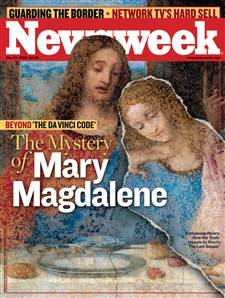 From Newsweek - May 29th, 2006 issue.
From Newsweek - May 29th, 2006 issue.“Why, then, did this woman, whom the New Testament tells us was Jesus' constant companion and whom the Gnostics claim was privileged above all others, disappear after the resurrection? If Mary were so important to Jesus, why is there no mention of her in Acts, or in the Epistles?”
- In the Eastern Orthodox Church she is called "The Equal of the Apostles."
- That she was young and pretty and led a sinful life. (It says in Luke 8:2 that the Lord expelled seven devils from Mary).
- From the moment of her healing Mary led a new life, and became a true disciple of the Savior.
- Together with the pious women Joanna, wife of Choza (steward of Herod), Susanna and others, she served Jesus from her own possessions (Luke 8:1-3) and undoubtedly shared with the Apostles the evangelic tasks in common with the other women.
- During Christ's Crucifixion she remained fearlessly at the Cross together with Mary, Jesus' Mother, and the Apostle John while all the other disciples ran away.
- She was the first to preach about the Resurrection. The Apostles proclaimed the Glad Tidings to the world, but she proclaimed it to the Apostles themselves.
- When the Apostles departed from Jerusalem to preach to all the ends of the earth, Mary Magdalene also went with them.
- She went beyond her native borders and went to preach in pagan Rome.
- Tradition relates that in Italy Mary Magdalene visited Emperor Tiberias (14-37 A.D.) and proclaimed to him Christ's Resurrection. According to Tradition, she took him a red egg as a symbol of the Resurrection, a symbol of new life with the words: "Christ is Risen!" Then she told the emperor that in his Province of Judea the unjustly condemned Jesus the Galilean, a holy man, a miracleworker, powerful before God and all mankind, had been executed and the sentence confirmed by the procurator appointed by Tiberias, Pontius Pilate.
- Thanks to Mary Magdalene the custom of giving gifts of "Easter" eggs on the day of the Resurrection of Christ spread among Christians over all the world.
- On one ancient Greek manuscript, written on parchment, kept in the monastery library of St Athanasius near Thessalonica, is a prayer read on the day of Holy Pascha for the blessing of eggs and cheese. In it is indicated that the igumen in passing out the blessed eggs says to the brethren: "Thus have we received from the holy Fathers, who preserved this custom from the very time of the holy Apostles, therefore the holy Equal of the Apostles Mary Magdalene first showed believers the example of this joyful offering."
- Mary Magdalene continued her preaching in Italy and in the city of Rome itself. Evidently, the Apostle Paul has her in mind in his Epistle to the Romans (16: 6), where together with other ascetics of evangelic preaching he mentions Mary (Mariam), who as he expresses "has bestowed much labor on us."
- She extensively served the Church in its means of subsistence and its difficulties, being exposed to dangers, and sharing with the Apostles the labors of preaching.
- She remained in Rome until the arrival of the Apostle Paul, and for two more years following his departure
- From Rome, St Mary Magdalene, as an older woman, moved to Ephesus where the Apostle John unceasingly labored. There the saint finished her earthly life and was buried.
- Her holy relics (remains) were transferred in the ninth century to Constantinople, and placed in the monastery Church of St Lazarus.
- During the Crusades they were transferred to Italy and placed at Rome under the altar of the Lateran Cathedral.
- Part of the relics of Mary Magdalene are said to be in Provage, France near Marseilles, where over them at the foot of a steep mountain a splendid church is built in her honor.
- The Orthodox Church honors the holy memory of St Mary Magdalene, the woman called by the Lord Himself from darkness to light, and from the power of Satan to God.
DOING IT BY THE BOOK
If I had to place my life in the hands of a surgeon, my first choice would be someone who had built their skill on years of training based on the traditions of their profession, rather than somebody who’d read a book on the subject – even if they’d memorized it!!
Likewise, if I were brought before a court accused of a crime, I’d want a well qualified Judge and Jury to base their judgment on the traditional interpretation of the law that places a high value on corroborative evidence of multiple eyewitnesses. Rather than be tried based on the purely personal interpretation of the law based on a popular novel or an article from Newsweek!!!
So why, when it comes to matters of eternal significance; like seeking the meaning and purpose of life, do we think that we can go with what “sounds” or “feels” right???
As Rob Bell, author of "Velvet Elvis," says: “If it’s true, it isn’t new.”
No comments:
Post a Comment